Any visit of Rome, Italy starts with its fabulous Roman ruins. After all, Rome is defined by its ancient past and the traces of one of the most fascinating civilizations that have ever lived. Some of the ancient sites that can be discovered in Rome are free to visit, while others are included in different passes and cards. You shouldn’t miss admiring any of them, because when in Rome…ruins are the highlight of your trip.
The city is very much a living museum, full of new things to learn and explore. For that reason, it’s among the top historical cities in the world, written about by students and scholars alike who either pay for an essay or write one about these marvelous ruins themselves. Either way, Rome is a treasure trove that is unparalleled for roman history lovers. There are so many historical facts about Rome, you can explore for years!
Everywhere you look, you will discover remains that whisper tales of the glorious ancient past of Romans and teach you lessons of ancient history which will become treasured memories. Here are the most remarkable and interesting Roman Ruins in Rome, Italy:
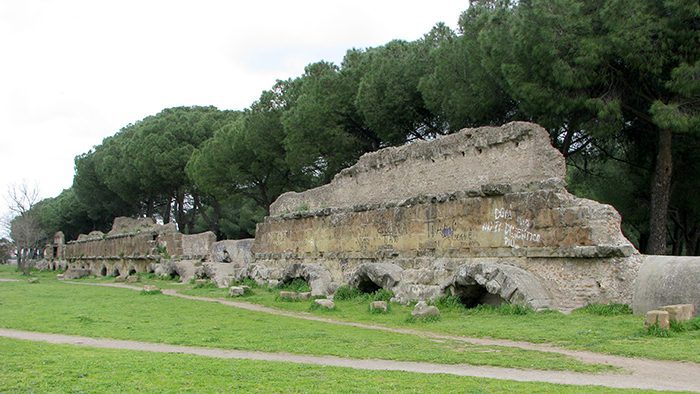
Acqua Marcia is one of the seven aqueducts of Rome, an imposing structure built between 44 and 42 BC. It was an imposing structure, but it didn’t age gracefully, an important section of it being destroyed during the construction of Felice Aqueduct.
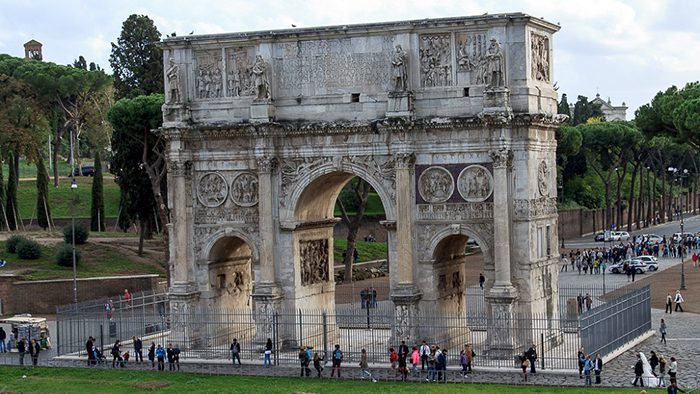
The famous Arch of Constantine, always present on tourists’ must see lists, was built on the order of the Roman Emperor Constantine the Great, in 315 AD. The arch was erected to honor the victory of Constantine following the Battle of Milvian Bridge that took place in 312 AD. It is very easy to locate because it is situated right next to even more famous Colosseum.

Another beautiful Roman arch that has survived the battle with time and nature is the Arch of Septimius Severus that can be admired in the Roman Forum. The arch was built in 203 AD and commemorates the victory of the Roman Emperor Septimius Severus against the Parthian Empire, a battle that took place between 194 and 199 AD.
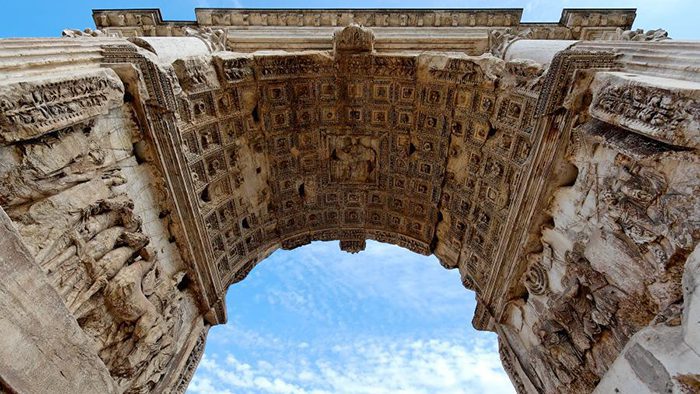
This arch too is situated close to the Colosseum and the Roman Forum and can be admired for free by any tourist interested in the history of the Roman Empire. The Arch of Titus was built from the initiative of the Roman Emperor Domitian who wanted to commemorate the victories of his elder brother, Emperor Titus. The arch was inaugurated soon after Titus’ death, in 81 AD, and is adorned with interesting depictions of the spoils of the ancient temple of Jerusalim.
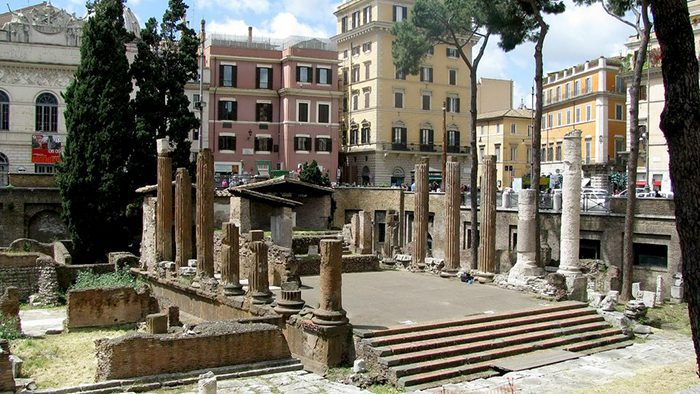
This is the name of a fascinating archaeological site in Rome which is home to four impressive temples named with letters from A to D. These temples were discovered in the 1920s, in the square of Largo di Torre Argentina, and since then have become an interesting attraction for tourists. Each temple comprises beautiful columns and walls. The oldest temple is temple C that dates back to the 3rd century, from around the same period the temple A was built. The temples B and D date from the 2nd century BC. The Area Sacra di Largo Argentina is also home to a cat shelter.
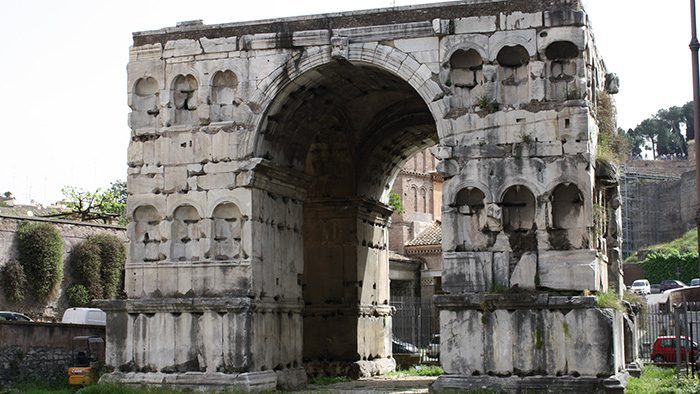
Although, as you’ve seen there are three more other arches in Rome, this arch is different and unique because it has four faces, a design featured which is known as “Quadrifrons”. The Arch of Janus dates back to the 4th century AD and it was built with brick and marble. It is believed that it was dedicated to the Roman Emperor Constantine the Great, and that’s why it is also named the Arcus Constantini. This arch, too, is situated in the vicinity of Colosseum and the Roman Forum.
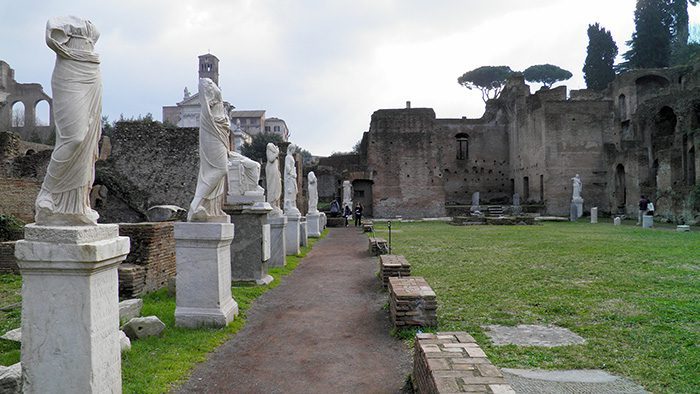
The Atrium Vestae, which means the House of Vestal Virgins, can be located in the Roman Forum. This was a palace that had fifty rooms where the priestesses and the goddesses of the hearth, Vesta, known as the Vestal Virgins, used to live. However, not much has survived from this palace, the only things that can be admired today being several statues displayed in a courtyard where some remains of the walls still stand.

The Aula Ottagona, or Octagonal Hall, is a part of the famous Diocletian Bath that will help you picture the immensity and splendor of this bath complex. This domed structure has managed to remain intact over the centuries and today it is used as a display area for exhibitions hosted by the National Roman Museum.
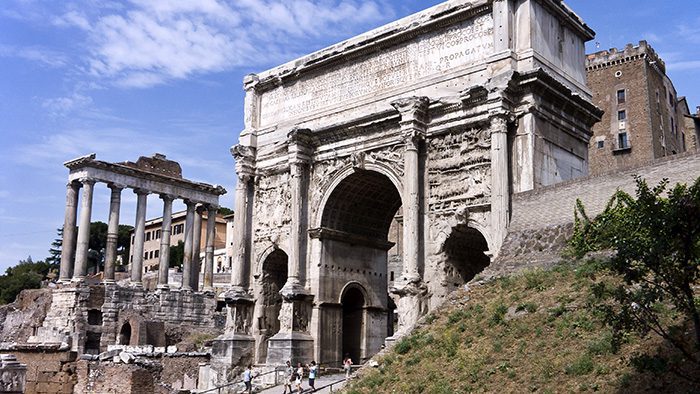
It is believed that this building dates from 179 BC but, along the centuries, it was rebuilt many times. This was the place where the traders of Ancient Rome used to meet and today it is one of highlights of the Roman Forum. The basilica was burned to the ground in the 5th century, but it was rebuilt, and today visitors can see a few remains of the columns and its pavement.
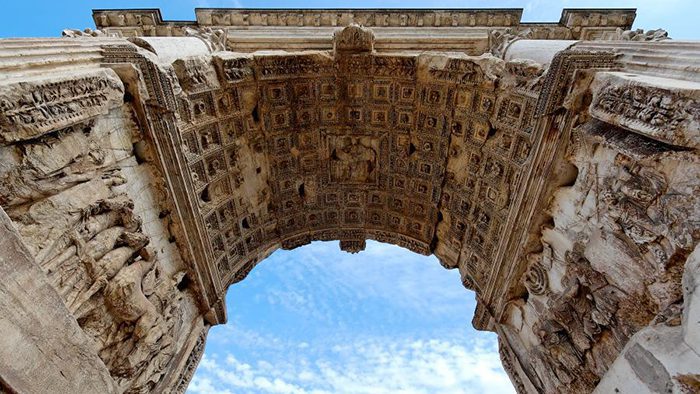
This basilica was actually a civil courthouse and also home to a few shops. It was founded by Julius Caesar in 54 BC, but it burned to the ground soon after its inauguration. Emperor Augustus rebuilt it in 12 BC, but the series of fires and rebuilding have continued over the course of time. This basilica is situated in the Roman Forum.
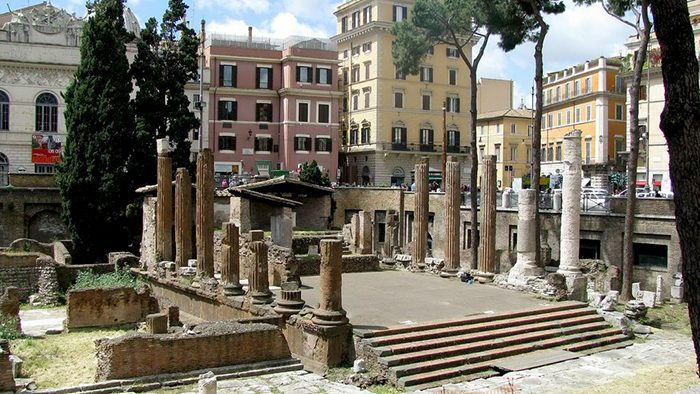
You will notice this basilica soon after arriving at the Roman Forum because this is the largest structure on-site and it still has its roof and three of its spectacular arches and vaults. The construction of this building started in 308 AD, when Rome was ruled by the Roman Emperor Maxentius, and was completed in 312-313 AD, during the reign of Constantine the Great. The basilica became a meeting house for the judicial or administrative council.

The Baths of Caracalla are a pretty famous touristic attraction in Rome, a destination that enchants all travelers who love to find everything about the secrets of ancient Rome. This bath complex is one of the best preserved ancient sites in the city and impresses visitors with its red-brick structures and many standing remains. The construction of this complex began in 206 AD, under the supervision of the Roman Emperor Septimius Severus, but it was finished only 10 years later, when his son, Caracalla, was the ruler of Rome.
The baths had an impressive number of rooms that could accommodate thousands of people. The complex was also home to shops, galleries, libraries and other leisure facilities. The original walls of the Baths of Caracalla are still standing and you can also admire impressive black and white mosaics that adorned the floors. Visitors have the possibility to visit the underground tunnels and corridors of this complex and see where the workers used to spend their days keeping the baths functional, and also the Temple of Mithras.
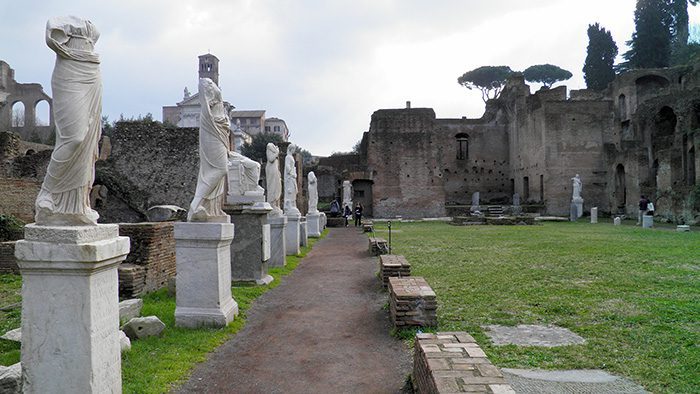
Another famous bath complex in Rome is the one build between 298 and 306 AD in honor of Roman Emperor Diocletian. The Baths of Diocletian were built following the typical bath design of Roman times, comprising a frigidarium, tepidarium and caldarium, large bathing chambers and gymnasiums. However, what makes these baths different from any other Roman baths is the impressive size of the complex which could accommodate up to 3,000 people at a time. There are many elements of the baths that have survived until our times, so you won’t get bored during your visit. A visit of the Aula Ottagona will help you make an idea about the grandeur of this complex. Complete your experience with a visit of the Museo Nazionale Romano – Terme di Diocleziano.
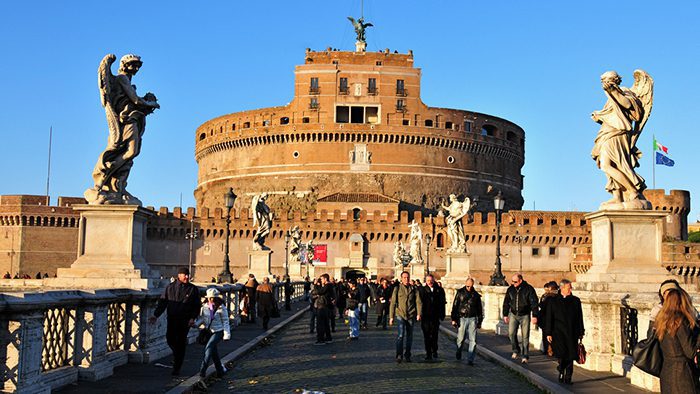
Many of us know about Castel Sant Angelo in relation with the popes that used to hide here when their lives were in danger, which used to happen pretty often. However, the Sant Angelo Castle was actually built to be a mausoleum for Roman Emperor Hadrian. It was built sometimes between 123 and 139 AD, and looked more like a fortress than a burial place. Roman Emperor Flavius Augustus Honorius decided to incorporate the castle into Rome’s Aurelian Walls, and this process led to the disappearance of many of the mausoleum’s contents. During the medieval era it became a stronghold and eventually a prison. The castle is linked to the Vatican Palace through an underground tunnel that sometimes is open for visits.
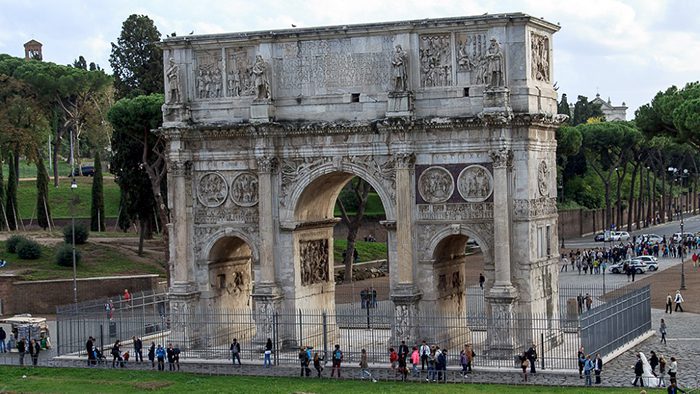
Rome is filled with catacombs of which only five are usually open to the public. The Catacombs of San Callisto are some of them. These catacombs date from around 150 AD and were an underground burial place for Christians. They have five floors where 500,000 bodies have found their eternal rest. There are some famous personalities buried here among which a few popes, but this is not the burial place of Pope St. Callixtus.
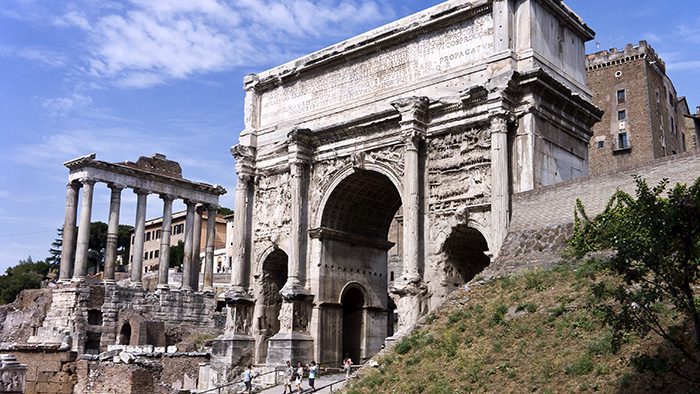
Circus Maximus in Rome is the structure to which all the ancient Roman circuses in the world are compared with. This was the largest sports stadium in Ancient Rome, mainly used as a scene for chariot races. At one point, after several reconstructions, the circus had a total capacity of 250,000 seats. Although, no one can say when the first version of this arena was built, it is sure that Circus Maximus was in use by the 4th century BC, so it is definitely the oldest arena in Rome.

Although it is much smaller than Circus Maximus, having a capacity of accommodating only 10,000 spectators, the Circus of Maxentius is far better preserved. It is situated on Via Appia and was built on the order of Emperor Maxentius who ruled Rome between 306 and 312 AD. Many elements of the circus are still standing, like its entrance towers and spina (central rome dividing line), so it is definitely worthy of a visit. Since the excavations continue on this site, we expect to have a chance and admire even more fascinating elements of this circus.
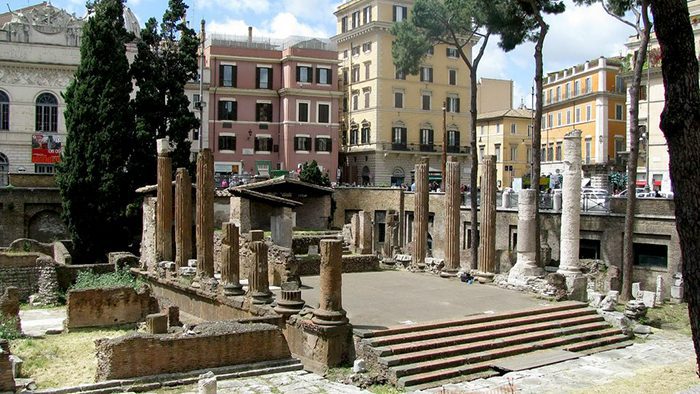
The construction of the Claudio Aqueduct started in 38 AD, under the reign of Emperor Caligula, but it was completed by the Roman Emperor Claudius, in 52 AD. A part of this aqueduct can still be seen today if you happen to visit the Appia Antica Regional Park.
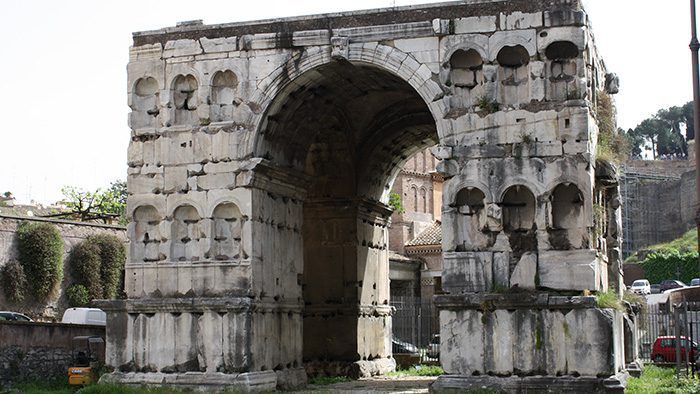
Many pages have been written about the Coliseum and there aren’t many travelers that didn’t hear about this fabulous Roman structure that seems to have discovered the secret of eternal youth. The Coliseum in Rome is a huge amphitheater that could accommodate up to 55,000 people and was the scene of many gladiator and animal fights. Its building started in 70 AD, but the arena was inaugurated only 10 years later.
The inaugural contest was rather bloody, over 5,000 wild animals being killed during the fights and many gladiators finding their end. It seems that because of these fights several species became extinct, creatures like the Middle Easter lion and North African elephant. The Coliseum illustrates all three ancient architectural styles: Doric, Ionic and Corinthian. Don’t wait in line, get your Skip-the-Line: Escorted VIP Entrance here.
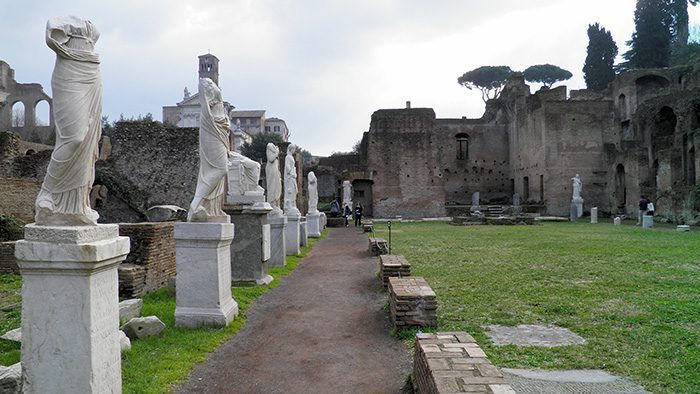
Curia Julia was the senate house of Ancient Rome, an imposing structure built during the reign of Julius Caesar. It was erected in the heart of the city and today it stands intact due to its conversion in the church of Saint Antonio, in 623 AD, on the order of Pope Honorius I.
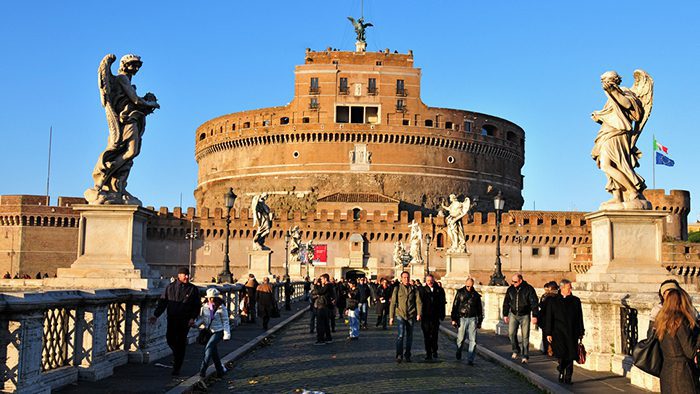
Domus Augustana was a magnificent palace built by Roman Emperor Domitian on the Palatine Hill. It was used as a residence for the emperors of Rome and it was one of the most incredible structures in Rome. Today, visitors can visit a beautiful courtyard where the remains of the palace’s walls and a fountain remind about the existence of the fabulous palace.
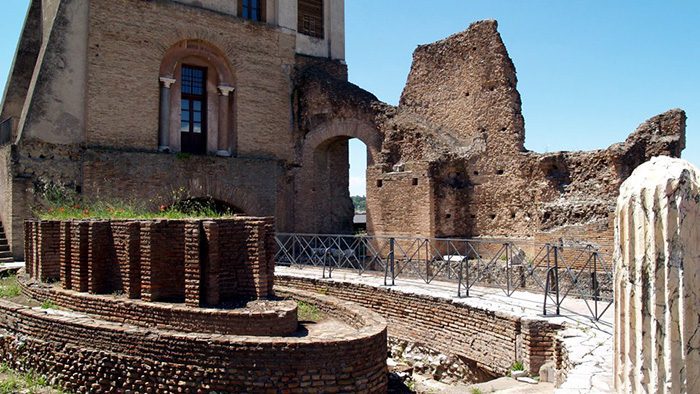
The Flavian Palace, also situated on the Palatine Hill, was the public palace of Roman emperors, the place where official functions were held. It was built by Emperor Domitian in the 1st century AD. The most remarkable remains of the palace are a few fountains that can be found in its courtyard.
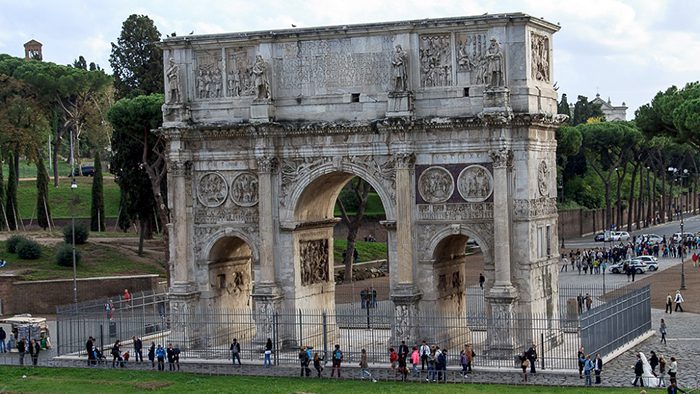
This was the first of the imperial forums that were constructed in Rome to relieve the overcrowded Roman Forum. Its construction started in 54 BC, on the order of Julius Caesar, and was completed in 46 BC, when Julius Caesar won a battle against his rival Pompey the Great. That is why the Forum of Caesar is also to the Temple of Venus Genetrix, a monument built to celebrate his victory. Visitors can still admire the columns and platform of the temple. However you need to know that these are not part of the original temple, who burnt down in 80 AD, but of a rebuilt version completed under the ruling of the Roman Emperor Trajan.
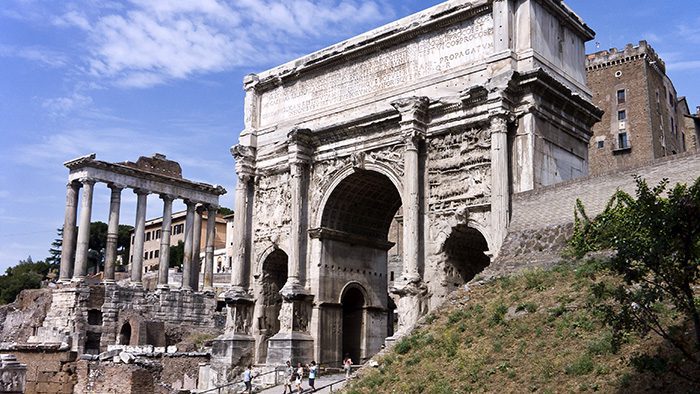
This forum was built between 107 and 112 AD, under the supervision of the Roman Emperor Trajan, after the emperor won several military campaigns, especially the conquest of Dacia. The site housed several public buildings and two libraries that used to flank the most important structure of the forum, the legendary Trajan’s Column. This 98-foot-high column is incredible well-preserved and it includes wonderful friezes that illustrate scenes from the Dacian Wars. During your visit here, you will also notice the remains of the Basilica Ulpia, an administrative center of Rome, and the beautiful Trajan’s Market, which some believe it was a shopping center, but it seems that it actually had an administrative role.
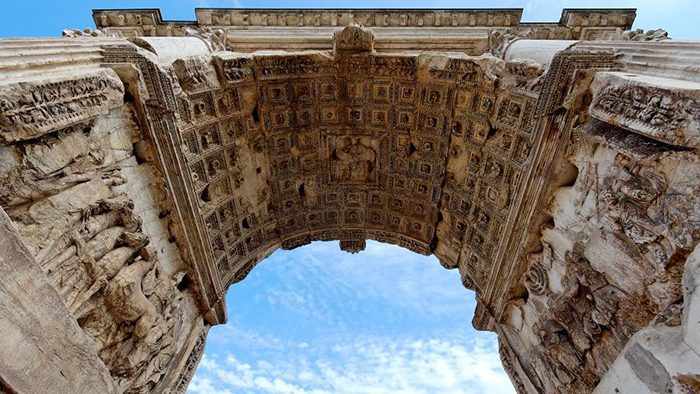
Covering an area of about 250 acres, Hadrian’s Villa is a fabulous complex considered to be the best preserved Roman villa in the world. It used to house about 30 buildings and many fascinating monuments, libraries, a colonnaded swimming pool, and a Maritime theater. This villa dates back to the 2nd century and surprises guests not only with its well-preserved ancient roman ruins, but also with a small island (home also to the emperor’s personal toilet), which was the secret retreat of Hadrian.
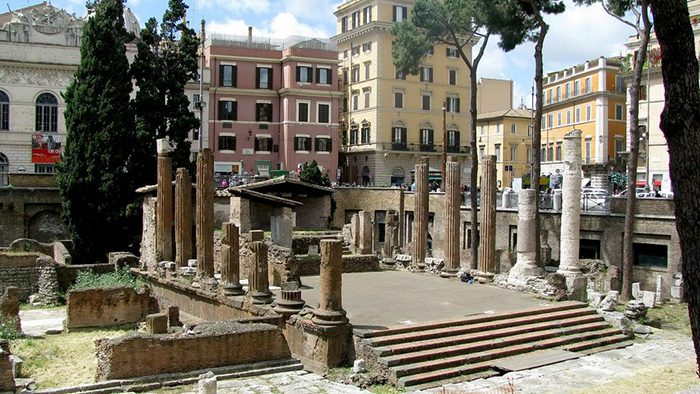
Ludus Magnus was the largest and most famous gladiator training school in Rome and it can be found in the vicinity of the Coliseum. It was built between 81 and 96 AD, on the order of Emperor Domitian, and rebuilt between 98 and 117 AD, during the reign of Emperor Trajan. The ancient ruins that can be admired today date from the time of Trajan. Visitors can admire the foundations of the spectator stands, the arena and the gladiator barracks, the water fountains from where the gladiators drank water during trainings and also their cells. The best view point to admire Ludus Magnus is from Via San Giovanni, the Roman road that connects the Coliseum with Basilica di San Clemente.

This Roman prison was in use from the 7th century BC, when it was built, to the 4th century AD. The historic ruins of the Mamertime prison are to be found under the church of San Giuseppe dei Falegnami, right next to the Roman Forum. You can access it via a winding staircase. Your effort will be rewarded with a glimpse into the last stop for many of ancient Rome’s criminals.
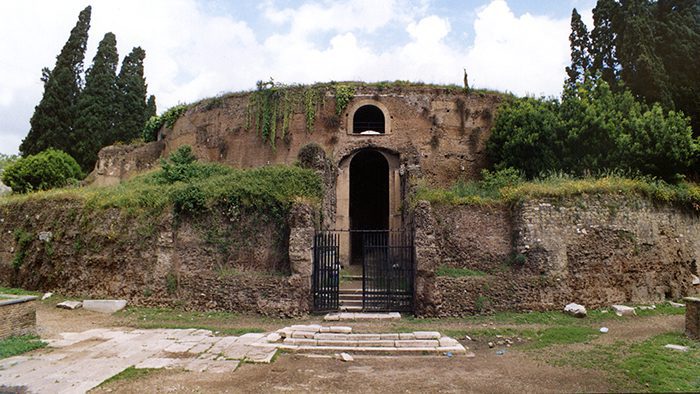
This is the tomb of the first emperor of Rome, everybody knows as Augustus. Augustus ruled between 63 BC and 14 AD and was the great nephew of Julius Caesar. The mausoleum was built around 28 BC and became a burial place not only for Augusts, but also for his wife, Livia, and other Roman emperors and public figures. Today, not much has survived from its former grandeur, and the mausoleum is close to the public. However, you can admire two of its obelisks in Piazza del Quirinale and Piazza dell Esquillino.

This very well-preserved tomb is situated on Via Appia and it is believed that it was built during the late 1st century AD. According to the inscriptions on the mausoleum, Cecilia Metella was a member of a very important Roman family, Quintus Caecilius Metellus Creticus, his father being a senior magistrate who had an important role in the conquest of Crete Island. Cecilia Metella’s husband was Marcus Licinius Crassus the Younger, also an important political figure during the ruling of Julius Caesar.
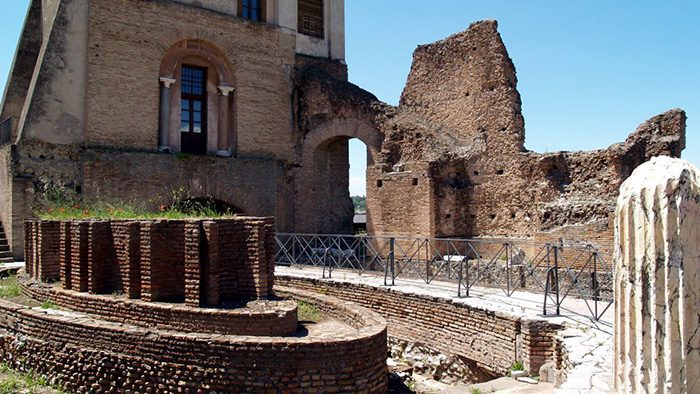
The Palatine Hill is not only one of the seven hills of Rome, but also the birthplace of Rome itself. The legend says that Romulus and Remus were taken by the she-wolf right here on this hill and this became the foundation of their village. We don’t know about the she-wolf, but the archaeologists have proven for a fact that this hill was the site where the first huts of Rome were built. This hill became one of the most important in Rome and is very rich in significations. This is where Augustus was born in 63 BC and also home to spectacular ancient sites like the Domus Augustana, the Palace of Septimius Severus, the House of Augustus and the House of Livia.
Visitors usually stop to also admire a partially-intact Stadium that was once part of Domus Augustana, the palace where Roman emperors lived. The Stadium was constructed on the order of Emperor Domitian but no one knows exactly what was its purpose. It is believed that was either a private garden or a horse riding arena.

The Pantheon of Rome is as famous as the Coliseum and it surely deserves its reputation. This is one of the most well-preserved ancient sites in Rome and a place that fascinates every tourist who visits Rome. It was originally built in 25 BC by Marcus Agrippa, as a temple dedicated to the most important gods of Rome, but a fire burnt it to the ground in 80 AD. However, the Pantheon was rebuilt in 125 AD, when Rome was ruled by the Emperor Hadrian, and this is the structure that you can admire today.
The highlight of this building is its original domed roof that has an oculus (circular opening). This dome was considered the largest dome in the world until the 15th century. In 609 AD, the Pantheon became a church and during the Middle Ages it was a burial chamber for important Italian figures. Get your 35-Minute Audio Guide Tour here.

Also known as Pons Aemilius, Ponte Rotto is the oldest stone bridge in Rome, a structure that dates from the 2nd century BC. Ponte Rotto was built to replace a wooden bridge. The only part that has survived the centuries is an arch, but it still worthy of a few minutes of your time.
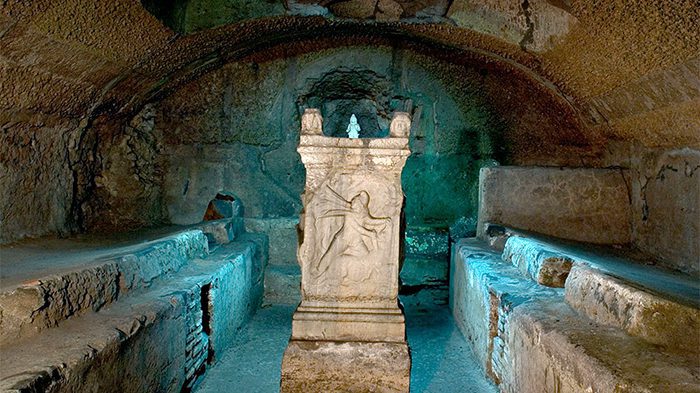
Although San Clemente is a 12th century basilica, the highlight of this site is actually the 4th century church and the Temple of Mithras that lie under the foundation of this basilica. To see these impressive roman ruins, visitors need to descend under the basilica. They will have a chance to admire one of the rooms of the temple, some very well-preserved frescoes and the ruins of a few Roman houses.
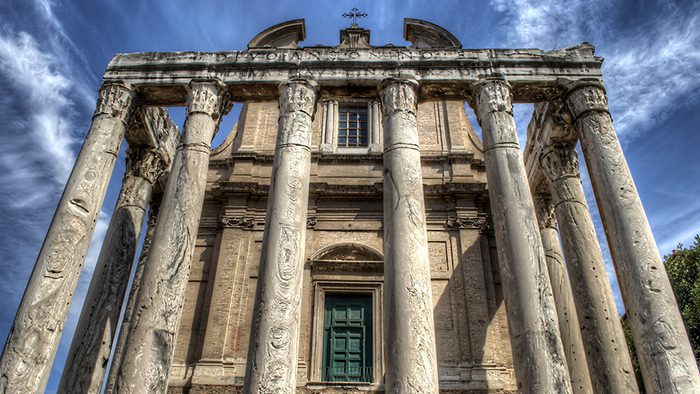
Another well-preserved Roman site, this temple dates from 141 AD, and was built from the initiative of the Roman Emperor Antoninus Pius to honor his wife, Faustina, who was deified after her death. 20 years later, the emperor died too and was also deified, so the temple that once was dedicated to Faustina became now the Temple of Antoninus and Faustina. Between 600 and 800 AD, the temple became a part of the San Lorenzo in Miranda church and that is why has managed to still be standing today.

This temple was built to honor Julius Caesar, who was assassinated on 15 March 44 BC, and following his death he was deified. It is situated in the Roman Forum and was erected on the site of Caesar’s cremation. The temple was completed in 29 BC.
Learn how to make some extra cash to travel to Rome by checking out BestMLMCompanies.com.
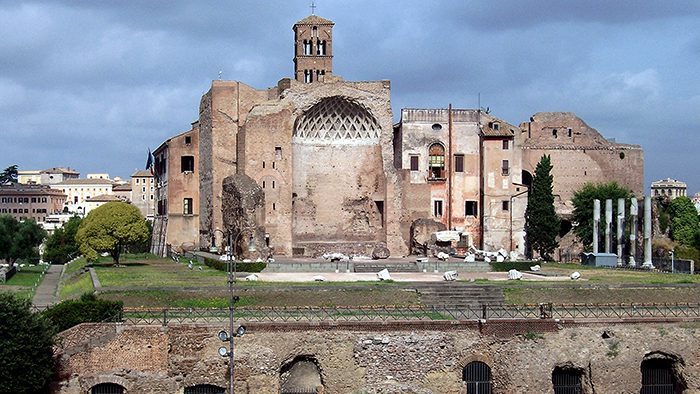
The Temple of Venus and Rome is situated at the east end of the Roman Forum, in the proximity of the Coliseum. It dates from 135 AD, and it is believed that the Roman Emperor of those times, Hadrian, was involved directly in designing the temple. The temple used to have two main chambers and it was a spectacular structure.
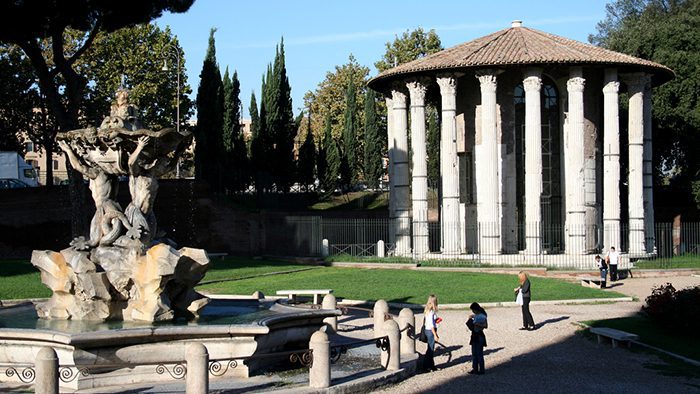
These two temples are among the best preserved temples in Rome. One of them is dedicated to Hercules Victor, while the other is known as the Temple of Portunus. Both temples date from the 2nd century BC and during the Middle Ages were incorporated into churches, hence their current state. The Forum Boarium used to be a part of the Roman cattle market but it eventually became a commercial center.
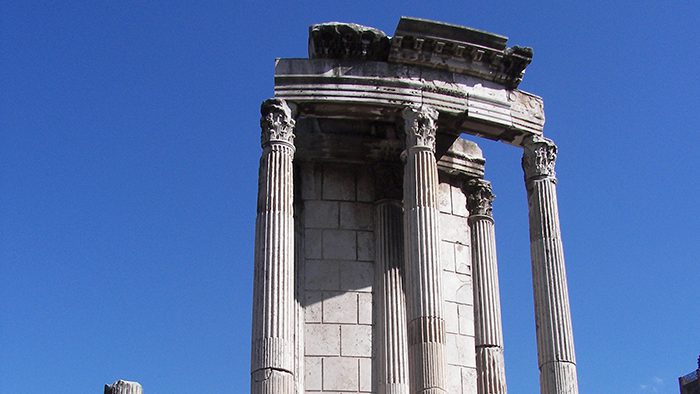
The Temple of Vesta was dedicated to the goddess of the hearth, Vesta, and used to house the eternal flame that was a symbol of the everlasting nature of Rome. If the flame was to be extinguished, it apparently seemed that Rome was doomed. The temple burnt down several times but it was rebuild every time. All that is left for us to admire today are three standing columns and a section of the fourth. The Temple of Vesta is situated in the southeast part of the Roman Forum.
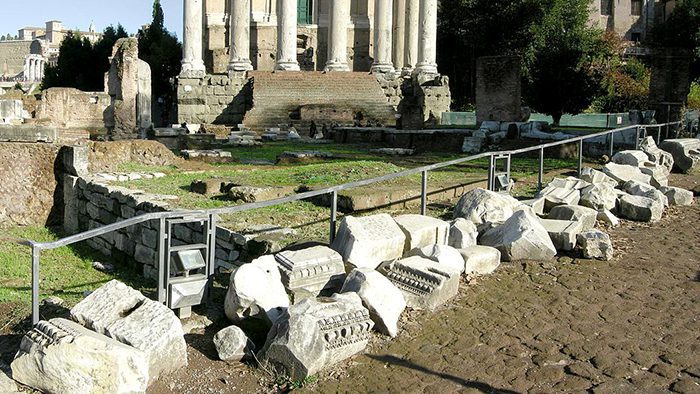
The ruins of Regia are situated in the Roman Forum and was built in order to accommodate the first kings of ancient Rome. Later, the building became the seat of the highest priests in Rome, the Pontifex Maximus, a title that was at some point attributed also to Julius Caesar. Except its ground floors, there is nothing much left from the Regia, but if you’re curious to see the remains, this site is situated near the Temple of Antoninus and Faustina.

Situated on Via Appia, this villa was one of the most luxurious residences in Rome. In 151 AD, this was the property of the wealthy Quintili brothers and housed its own private thermal baths. These brothers enjoyed the favors of Marcus Aurelius, but the Roman Emperor Commodus didn’t share the same opinion with Marcus Aurelius. During his reign, the brothers were executed and their lavish villa became the property of the emperor. The villa is relatively well-preserved and you can still distinguish its thermal baths.
Here are five awesome tours I recommend in Rome:
NOTE: Before you travel internationally, make sure all of your necessary travel documents are up-to-date! Keeping copies of them with you can help make your travel experience a smoother, less stressful experience.
Have you visited any of these 40 Roman Ruins in Rome, Italy? Leave us a question or comment below!
Counter
101 Countries • 1432 Cities
Aldo Moscarda says:
Enjoyed the display greatly I too would like to visit the eternal city and take a few weeks to do that.In 1978 my wife and I went to Rome for several days.Well that was the entree, awaiting main meal which is within grasp now
David says:
Amazing Aldo! I am back there early November 🙂
Anthony says:
This is an amazing article with clear photos such that going through it one feels like they have visited Rome.As a catholic from Africa my one desire is to ever visit this eternal city in my lifetime.I realize that the ruins hold some mystery because one cannot comprehend how at a time when there were no machines the ancient Romans could build such grand and strong architectural works.
tim says:
Hi David…great insightful page . Seek your advice. We have 2 full days in Rome, of the so many wonderful things are the 3 “cant miss” things to see.
many thanks Tim
Ender's Shadow says:
As someone doing an MA in church history – I’m embarrassed to say I’ve not got to Rome yet in my life. I have hope to make it this year, and this is a depressingly long list to start on…
David says:
It is.. don’t worry this took many visits. Just visit the most important ones 😉
Carol says:
Thanks for posting this. Like…! But, you placed an image of the temple of Saturn with the text on the temple of Caesar..
David says:
Wow sorry about that! Thank you for letting me know about the error. Will fix soon!
Adrienne says:
i have been to all of them. I go with a guide, who is a friend, on his Vespa!
I studied art history and archeology in college in New York and have visited Italy at least 10 times. I find what lies beneath adds so much history and meaning to what lies above!
David says:
Thank you Adrienne for your beautiful comment! This is so true! – I find what lies beneath adds so much history and meaning to what lies above!